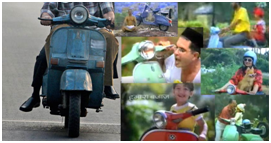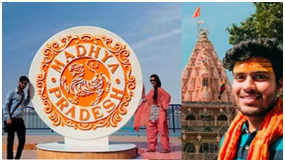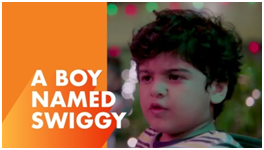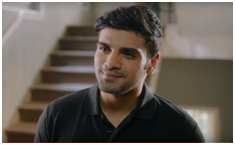Storytelling from the Perspective of Indian Advertising: A Strong Relationship with Brand
“People forget facts, but they remember stories.”- Joseph Campbell
Abstract
The purpose of this study is to focus on the Indian Ad films and to understand how they connect the brand with the customer. The purpose of advertising is to communicate the message to mass. To communicate the message, advertisers use various media of communication like Print, Radio, TV advertisement and new media of communication. These media communicate the message effectively to mass. An Ad film is a combination of the visuals, sound and the dialog (copy). There is a specific message behind each ad film-like, to pass the information related to the product and service or to educate the customer. Selling the product in India is like a competitive war. There are various types of products available in the market with their U.S.Ps. Promoting the product requires proper direction & planning. In the journey of ad films, “change and constant” play important roles. The successful connection of the brand with the customer establishes a recall value of the brand. In comparison to the other media of communication, ad films can quite easily pass the message to mass as it is easy to remember stories. Short stories easily connect conveying the purpose and the service with their unique features. India is famous for its diversity. It is a land of various cultures and traditions. There are several stories from our surroundings that are dramatically presented by the advertiser to communicate their message effectively. New media of communication like Facebook, Instagram give a new platform for mass communication and new media allow the viewers to react to them (Interactive media). Further, case studies will focus more on how creative people observe their surroundings and create stories with emotion, humorous and sentiments and incorporate a specific message in them.
Keywords: Advertising, Ad Film, Stories, Communication, advertisement
Introduction
“The Institute of Practitioners in Advertising definition says: ‘advertising presents the most persuasive possible selling messages to the right prospects for the product or service at the lowest possible cost. Advertising belongs to the modern industrial world, and to those countries which are developing and becoming industrialized. In the past when a shopkeeper or stallholder had only to show and shout his goods to passersby, advertising as we know it today hardly existed. Early forms of advertising were signs such as the in sign, the red and white striped barber’s pole the apothecary’s jar of colored liquid and wheelwright’s wheel, some of which survived until today.”[1] Advertising is the art of marketing, which is required for mass communication. To promo, the brand manufactures use the Campaign planning. “The term ‘Campaign Planning’ has been imported into advertising from military strategy. Advertising strategy which is designed to support adequately the marketing strategy when translated into a plan of action is known as campaign planning in Advertising.”[2] Advertising campaign covers the various media communication to spread the message effectively. The media are like Print advertisement, Radio spot, and Ad Films. Ad films are a combination of the Characters, Music and the Copy (Dialogue). In an advertising campaign, ad films have special attention-getting perspective for the customer. Ad films connect and present the problem and its solution dramatically. Which widens up the customers viewpoint and establishes a relationship with the brand?
The specific reason for advertising
There are several specific reasons to advertise. Brands advertise and engage into promotional activity for the following goals. (a) To expand the market to new buyers. (b) To announce price change (c) To make a special offer. (d) To Reminder (e) To Maintain Sale (f) To attract investors. [3]
Growth of Indian Advertising
India is a growing economy, providing huge opportunities for the growth of various industries. Though the global media and entertainment industry is showing slow growth rate in 2017, India is expected to be one the opportunistic market to show rising trends against the global trend. The advertising industry is one of the most important sectors of the media and entertainment industry. Indian government provides remarkable support to the advertising industry. India is the 2nd fastest growing advertising market in Asia, with an expected contribution to GDP in 2018 to reach 0.45%. Advertising expenditure is growing in India and in 2018 it is expected to grow by 12.5%. Internet advertising revenue share in the total advertising revenue has grown from 8% in 2013 to 14% in 2017, expected to reach USD 1.5 billion by 2018. The improving market sentiments, RBI policies and the opening of newly licensed banks in India is giving ample space for advertising expenditure in the financial sector. Further, ‘Digital India’ policy by the government is expected to outperform in coming years with the support of Google and thus drive the growth of the advertising industry. Goldstein Research analyst forecast that the India Advertising Industry is set to reach USD 54.39 billion by 2024 growing at a CAGR of 26.30% over the forecast period (2017-2025).[4]
Ad films in the era of social media
In the era of information and technology, social media are the best platform to release ad films, and web banners; the new media of communication also gives new wings to creativity and a platform to present new ideas. “In this year’s Digital Advertising Report, Nawal Ahuja, co-founder and director of Exchange4Media, says, “Digital ad spends will touch almost ₹19,000 crore in three years, almost the same as the size of the print ad industry today.”[5] “The scope of social media in India is immense and increasing rapidly. It is the 10th biggest economy and also has the 2nd largest population in the world. A survey in 2019, which includes the top businesses, admitted that 15-20% of their marketing budget is allocated for social media advertising. Based on the Statistical analysis it is been found that the number of users of the social network in India will be 258.27 million. It is a drastic rise from approximately 168 million users in 2016. India is encountering development in the number of mobile users; regardless it contains just 16 percent of the nation’s aggregate populace with access to the web. In addition, it is assessed that India’s web clients will end up noticeably the world’s biggest web base, after China and the US.”[6]
Role of Advertising Appeal in an ad film
Advertising appeal is the central idea of an advertisement. An appeal is any statement designed to motivate a person for action. Advertisements are generated from an idea. This idea has been designated as the advertising theme, the appeal. An appeal must relate to the Consumer's interests, wants, goals or problems. Consumers buy products or services to fulfill specific tasks or to have specific experiences. Different types of appeals generate various needs and wants that motivate the customers to buy products or services are. Those appeals mostly are: (1) Positive and Negative Appeals (2) Emotional and Intellectual Appeals.
The Positive appeal adopts a positive approach to show stories that influence the consumers to buy the product or service. Simply put, positive appeal tries to dramatize the advantages, benefits or situations which are gained when the consumer uses the product. Advertisers use positive appeals to motivate consumers.
Negative appeals are also called Fear appeals. For example, an advertisement for an insurance policy may depict the consequence of a thief or robbery – a family loses all its money and jewelry in the absence of insurance. Many advertisers believe that fear is the greatest motivational force because fear succeeds in drawing urgent attention of the consumer. The negative appeal does not create goodwill easily.
Ad films and consumer behavior
Thus buying motives are a source of consumer behavior. It also happens that at a time more than one need may exist in a consumer. Psychologists give a lot of importance to the study of buying motives, for advertising to be effective. The advertiser makes an effective appeal by directing his messages to the appropriate buying motives of the consumers. (Physiological, security, Health, The desire for Comfort, Love needs, Belongings, Fear, Egotism & Vanity, Profit, Aesthetics, Imitation, Fashion and Novelty, Pleasure, Convenience, Urge to Achieve, Patronage, Desire for new experience)
Ad films in India
There are various ad campaigns in India. Some of them leave huge impression on the consumer's mind. The ad campaigns are based on specific messages and they use various media of communication to spread the message. The basic idea behind the advertising camping is to focus on the information, persuasion, and reminder.[7]
An animated short educational film titled ‘Ekchidiya, anekchidiyan’ (One bird, many birds) was released on public broadcaster Doordarshan. The film, intended to teach the values of unity and teamwork to children, became immensely popular.
In 1989. When Bajaj released the famous “Hamara Bajaj” ad campaign. The 1989 Hamara Bajaj ad campaign by the brand took a very unconventional route, one that succeeded but could just as easily have backfired, because it was so unusual. The half-minute ad showed Indians with their Bajaj scooters in different situations – from jogging to haggling to celebrating to learning how to ride. It was not as if the scooter was doing something dramatic or spectacular in the ad – it was just there in the most normal way possible, which was how it actually was in real life.[8]

Image 1

Image 2
Storytelling in Advertising
Storytelling allows marketers to develop a deeper connection with the audience. Storytelling is a fundamental human experience that unites people and drives stronger and deeper connections. Stories communicate messages in highly specific and emotionally impactful ways. They’re memorable, and they give us something to identify ourselves with and hold on to. Statistics tell us what the reality is—stories tell us why it matters and why we need to care. Storytelling the stories that a brand believes in will immediately help set the brand apart from other competitors. Story is what makes a difference in the brand image and it can help potential customers trust and become invested in the brand. [9]
What Kind of Stories is most effective in Advertising?
Emotional impact and reliability are the key features of thoughtful stories. Thoughtful stories are on the bases of the USP and the message which they wanted to convey to the mass. Brand’s stories must be convincing enough to the target audience and must motivate them to trust the brand. When one says “choose a story that connects with your target audience,” many businesses try to focus on the most generalized story possible to appeal to as large of an audience as possible. They may skip over details. A good writer knows that the more specific, detailed, and personalized a story is, the more it will appeal to larger groups of people. In the journey of Indian ad films, several ad films have played an important role in the industry. Ad films carry the various areas and aspects of the society and coming up from the Indian ad films.
Case study 01
Madhya Pradesh tourism
Madhya Pradesh tourism comes up with the new campaign which is the World’s most honest film’ In ad film the team at Ogilvy and Hungry Films shot 40,000 pictures and chose 500-600 to create the ad. According to Azazul Haque, Chief Creative Officer, Ogilvy South, Most often, tourism ads on the television show beautiful landscapes, rivers flowing, birds chirping, snow-clad mountains, amazing monuments, and mouth-watering food to attract tourists to visit those breath-taking locations. But on ground zero, the charm the pictures depict is sometimes missing and the ad seems misleading. Keeping this in mind, Ogilvy decided to take a bold step and created an ad for Madhya Pradesh Tourism, ‘Memories of Destination’, and it became the ‘World’s most honest film’. It showed the real side of MP with real pictures clicked, posed and sent by tourists. The ad is an amalgamation of stop motion of pictures shot by tourists and travelers across MP. The film shows the heart of India, Madhya Pradesh, as it is without any touch-up or filter. [10]

Image 3
Case Study 02
For India, there is a new business setup in the market which is online food delivery, there are several companies in the online delivery business like UBER Eat, Zomato, and Swiggy. Swiggy is an online business prevalent in India that functions by allowing people to order food over the internet. The brand’s rise to fame is mostly predicated to the wide usage of its mobile application, but customers also have the ability to use the service via a web browser on their computers. The brand’s recent campaign emphasizes the need to have a dignified response towards the individuals that deliver food on the business’s behalf. The campaign named #WhatsInaName makes a simple argument; it asks the customers to call the delivery representatives by their names instead of using the moniker, Swiggy. The short film encapsulating the idea takes the viewers through the satirical story of a little boy born with the name, Swiggy. The film showcases instances of embarrassment that the boy faces owing to his peculiar name. In the final act, the video presents the message that referring to Swiggy’s food-delivery representatives by their actual names will lead to a more humanitarian utilization of the service. [11] To spark a behaviour and cultural change, they crafted a film about a boy called Swiggy. Inspired by the Bollywood School of storytelling, the saga drove home the point that every person has a name and just the simple act of acknowledging this can make them feel respected. [12]

Image 4

Image 5
Indian culture gives the new scope to the Creativity and the Innovations
The culture of India is the oldest culture of the world around 5,000 years. Indian culture is considered as the first and supreme culture of the world. There is a common saying about India that “Unity in Diversity” means India is a diverse country where people of many religions live together peacefully with their own separate cultures. People of various religions differ in their language, food tradition, rituals, etc however they live with unity. Creativity and the Innovations are the two piles of advertising, Since time immemorial, stories have been an integral part of human civilization. Communicated through varied forms – cave paintings, oral traditions, dance & drama, puppet shows – stories have been an inevitable part of every culture. Stories have been a significant part of our childhood as well- bedtime stories, to stories that were told to make feeding time easy, to stories that instilled moral values and made us understand the importance of the culture we are living in or stories that just amused us. This amazing mix of facts and fiction is so powerful in shaping beliefs and perceptions in our mind that before we know it they become critical while making important decisions of our lives. To promote or to present the USP of the product in the right context they dramatically present the idea. While the story should focus on something that people care about, the brand should only be a part of the narrative. It is much beyond communicating the benefits of the products or services and more about creating an emotional connection with the consumer. When you give your consumer an interesting story to share within his / her circle, it becomes the most effective form of marketing at times. [13]
Conclusion
Standing out amongst the crowd has always been a challenge in advertising. There are various Media of communication available to present the idea to mass, but ad film has its own charm to communicate a message. “Change and constant” plays an important role in ad films. Technology especially multimedia gives a new horizon to designers. Indian culture plays an important role in the ad films Madhya Pradesh tourism come up with the new campaign which is the World’s most honest film’ which depicts the real pictures. The ad is an amalgamation of stop motion of pictures shot by tourists and travelers across MP, Commonly the traveling and the memory of the different places are the most important aspects of the tour and play with the memory of Madhya Pradesh tourism. In another ad for the delivery boys of Swiggy dignified response towards the individuals that deliver food on the business’s behalf. The campaign named #WhatsInaName makes a simple argument; it asks the customers to call the delivery representatives by their names instead of using the moniker, Swiggy. These stories create a memorable impact on the viewers. Apart from showing the beliefs and values of the brand, these ad films also stand for a better society and awareness regarding the same. Storytelling is one of the most effective ways to set up a brand image. As stories reflect our society, ad films reflect what the brand is doing for the society.
Reference
- Jefkins, F. and Yadin, D. (2000). Advertising. London: FT Management, p. 05.
- Rege, G. (1984). Advertising art and ideas. Bombay: Ashutosh Prakashan, pp.64-65.
- Jefkins, F. (1992). Advertising. 3rd ed. Calcutta: Rupa.Co, pp.3-12.
- Goldsteinresearch.com. (2019). Advertising Industry In India: Trends, Growth, Market Research Report 2025. [online] Available at: https://www.goldsteinresearch.com/report/india-advertising-market [Accessed 20 Jan. 2020].
- The Hindu. (2018). How digital technology is changing the face of marketing in India. [online] Available at: https://www.thehindu.com/sci-tech/technology/internet/how-digital-technology-is-changing-the-face-of-marketing-in-india/article24172999.ece [Accessed 21 Feb. 2020].
- blogs, V. (2019). What is the Scope of Social Media Marketing in India in 2020?. [online] AvivDigital. Available at: https://avivdigital.in/scope-of-social-media-india/ [Accessed 21 Feb. 2020].
- Courses.lumenlearning.com. (2020). Promotion: Integrated Marketing Communication (IMC) | Introduction to Business [Deprecated]. [online] Available at: https://courses.lumenlearning.com/wmopen-introbusiness/chapter/promotion-integrated-marketing-communication-imc/ [Accessed 21 Feb. 2020].
- The Indian Express. (2019). Indian Ad-Age: How Hamara Bajaj felt the heartbeat of a nation. [online] Available at: https://indianexpress.com/article/entertainment/opinion-entertainment/indian-ad-age-hamara-bajaj-ad-6018249/ [Accessed 21 Feb. 2020].
- Gotter, A. (2017). Storytelling: The Key to Effective Advertising. [online] Disruptive Advertising. Available at: https://www.disruptiveadvertising.com/marketing/storytelling-advertising/https://www.disruptiveadvertising.com/marketing/storytelling-advertising/ [Accessed 21 Feb. 2020].
- Nath, M. (13/8/2018). What made MP Tourism’s Memories of Destination ad the ‘World’s most honest film’. [online] www.bestmediaifo.com. Available at: https://bestmediainfo.com/2018/08/what-made-mp-tourism-s-memories-of-destination-ad-the-world-s-most-honest-film/ [Accessed 21 Feb. 2020].
- Campaigns of the World®. (2018). Swiggy - What’s in a name | A humanitarian take at food-delivery associates. [online] Available at: https://campaignsoftheworld.com/digital/swiggy-whats-in-a-name/ [Accessed 21 Feb. 2020].
- Adsoftheworld.com. (2019). Swiggy Film Advert By : What's In A Name | Ads of the World™. [online] Available at: https://www.adsoftheworld.com/media/film/swiggy_whats_in_a_name [Accessed 21 Feb. 2020].
- The Next Ad. (2019). Storytelling And Advertising: How To Bring The Two Together - The Next Ad. [online] Available at: https://www.thenextad.com/blog/storytelling-and-advertising-how-to-bring-the-two-together/ [Accessed 21 Feb. 2020].
- Vithlani, K. (2018). The Art of Storytelling in Advertising. [online] Marshmallow Blog. Available at: http://www.marshmallow.in/blog/art-storytelling-advertising/ [Accessed 21 Feb. 2020].
Image Source
- https://www.business-standard.com/article/companies/40-years-ago-and-now-hamara-bajaj-clarion-call-for-consumerism-114100801244_1.html
- https://english.manoramaonline.com/business/autos/2018/07/23/humara-bajaj-nostalgia-fond-memories.html
- https://bestmediainfo.com/2018/08/what-made-mp-tourism-s-memories-of-destination-ad-the-world-s-most-honest-film/
- https://www.exchange4media.com/advertising-news/swiggy-at-five-how-the-app-has-delivered-creative-hits-over-the-years-98749.html
- https://brandequity.economictimes.indiatimes.com/news/advertising/swiggys-latest-ad-campaign-whatsinaname-strikes-a-chord-with-millions-of-indians-who-order-food-online/66837086